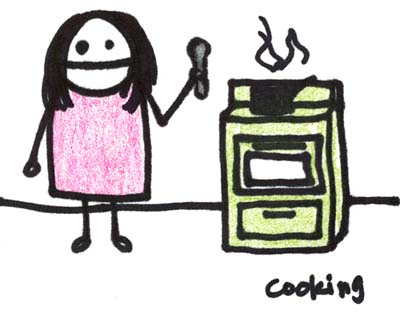 Proteins
ProteinsEdible animal material, including muscle, offal, milk and egg white, contains substantial amounts of protein. Almost all vegetable matter (in particular legumes and seeds) also includes proteins, although generally in smaller amounts. These may also be a source of essential amino acids. When proteins are heated they become de-natured and change texture. In many cases, this causes the structure of the material to become softer or more friable - meat becomes cooked. In some cases, proteins can form more rigid structures, such as the coagulation of albumen in egg whites. The formation of a relatively rigid but flexible matrix from egg white provides an important component of much cake cookery, and also underpins many desserts based on meringue.
Liquids
Cooking often involves liquids, both added in order to immerse the substances being cooked (typically water, stock or wine), and released from the foods themselves. Liquids are so important to cooking that the name of the cooking method used may be based on how the liquid is combined with the food, as in steaming, simmering, boiling, braising and blanching. Heating liquid in an open container results in rapidly increased evaporation, which concentrates the remaining flavors and ingredients - this is a critical component of both stewing and sauce making.
Fat
Fats and oils come from both animal and plant sources. In cooking, fats provide tastes and textures. When used as the principal cooking medium (rather than water), they also allow the cook access to a wide range of cooking temperatures. Common oil-cooking techniques include sauteing, stir-frying, and deep-frying. Commonly used fats and oils include butter, olive oil, sunflower oil, lard, beef fat (both dripping and tallow), rapeseed oil or Canola, and peanut oil. The inclusion of fats tends to add flavour to cooked food, even though the taste of the oil on its own is often unpleasant. This fact has encouraged the popularity of high fat foods, many of which are classified as junk food such as hamburgers or convenience fried cereal snacks.
Carbohydrates
Carbohydrates used in cooking include simple sugars such as glucose (from table sugar) and fructose (from fruit), and starches from sources such as cereal flour, rice, arrowroot, potato. The interaction of heat and carbohydrate is complex.
Long-chain sugars such as starch tend to break down into more simple sugars when cooked, while simple sugars can form syrups. If sugars are heated so that all water of crystallisation is driven off, then caramelisation starts, with the sugar undergoing thermal decomposition with the formation of carbon, and other breakdown products producing caramel. Similarly, the heating of sugars and proteins elicits the Maillard reaction, a basic flavor-enhancing technique.
An emulsion of starch with fat or water can, when gently heated, provide thickening to the dish being cooked. In European cooking, a mixture of butter and flour called a roux is used to thicken liquids to make stews or sauces. In Asian cooking, a similar effect is obtained from a mixture of rice or corn starch and water. These techniques rely on the properties of starches to create simpler mucilaginous saccharides during cooking, which causes the familiar thickening of sauces. This thickening will break down, however, under additional heat.
Food safety
If heat is used in the preparation of food, this can kill or inactivate potentially harmful organisms including bacteria and viruses. The effect will depend on temperature, cooking time, and technique used. The temperature range from 5°C to 57°C (41°F to 135°F) is the "food danger zone." Between these temperatures bacteria can grow rapidly. Under the correct conditions bacteria can double in number every twenty minutes. The food may not appear any different or spoiled but can be harmful to anyone who eats it. Meat, poultry, dairy products, and other prepared food must be kept outside of the "food danger zone" to remain safe to eat. Refrigeration and freezing do not kill bacteria, but only slow their growth. When cooling hot food, it shouldn't be left on the side or in a blast chiller (an appliance used to quickly cool food) for more than 90 minutes.
Cutting boards are a potential breeding ground for bacteria, and can be quite hazardous unless safety precautions are taken. Plastic cutting boards are less porous than wood and have conventionally been assumed to be far less likely to harbor bacteria.[1] This has been debated, and some research have shown wooden boards are far better.[2] Washing and sanitizing cutting boards is highly recommended, especially after use with raw meat, poultry, or seafood. Hot water and soap followed by a rinse with an antibacterial cleaner (dilute bleach is common in a mixture of 1 tablespoon per gallon of water, as at that dilution it is considered food safe, though some professionals choose not to use this method because they believe it could taint some foods), or a trip through a dishwasher with a "sanitize" cycle, are effective methods for reducing the risk of illness due to contaminated cooking implements.
No comments:
Post a Comment